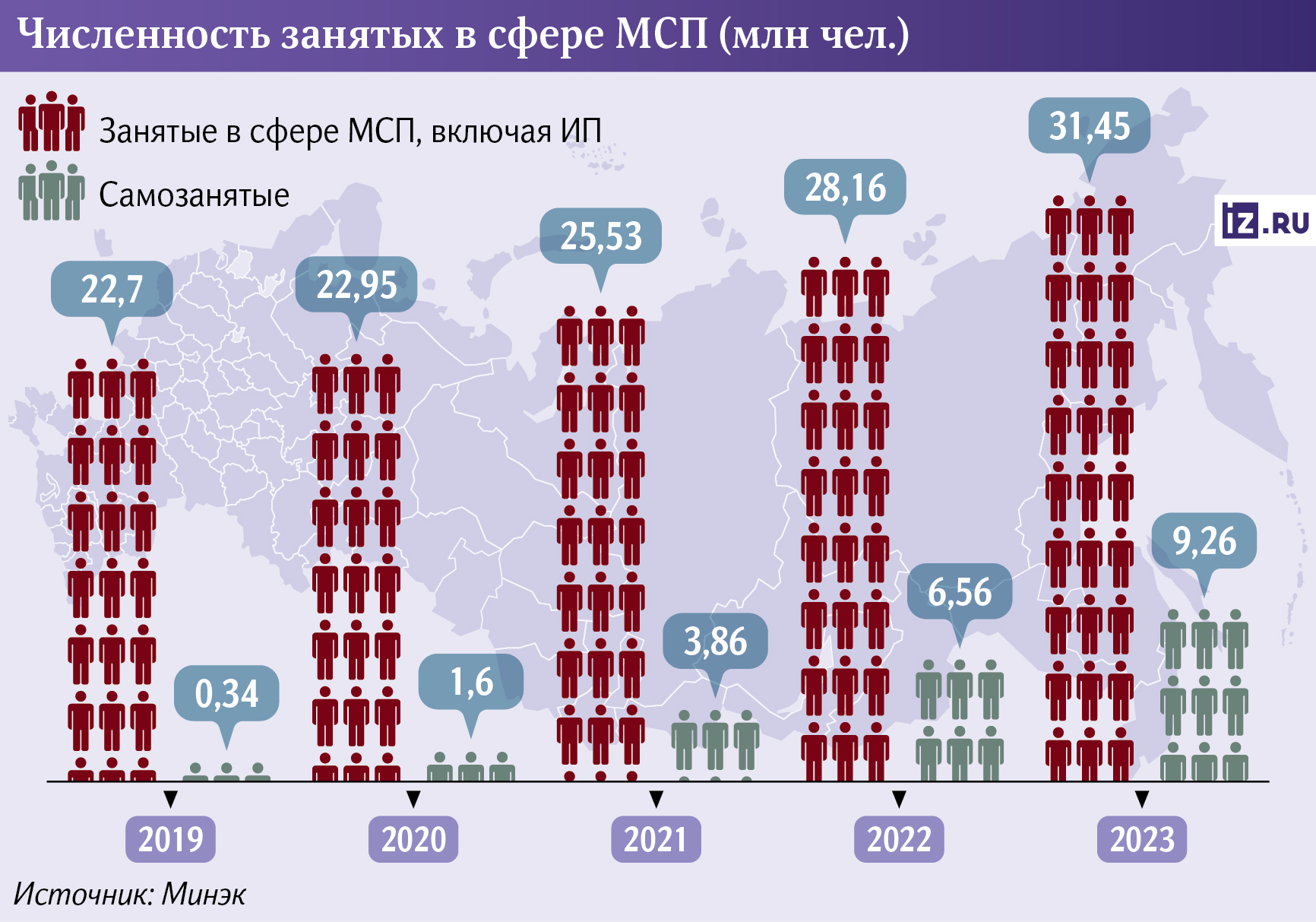Small is in shape: the number of employed SMEs exceeded 31 million

In Russia, the number of people employed in small and medium-sized businesses has grown one and a half times during the period of the national project to support them - up to 31.5 million people in 2023. This follows from the Ministry of Economic Development's report (Izvestiya has it). Despite the fact that the share of those employed in the sector is about 40% of the total number of those working in the country, their contribution remains at just above 20% of GDP. Despite the fact that the goal of the national project was to increase the figure to 32%. The sector is mainly growing at the expense of the self-employed. How the authorities will change their approach to supporting small companies and why they are important for the economy - in Izvestia's article.
How many SME companies operate in Russia
Employment in SMEs has increased one and a half times since 2019 - since the launch of the national project to support SMEs and individual entrepreneurial initiative. In 2023, the number of people working in this sector reached 31.45 million people - this includes sole proprietorships and the self-employed. Such data follow from the report of the Ministry of Economic Development "On the state of small and medium-sized enterprises in Russia and measures for its development in 2019-2023", which also summarizes the results of the national project.
- The growth of the sector was ensured by the comprehensive support of business within the framework of the National Project: these are targeted financial instruments, educational support for all categories of entrepreneurs, development of infrastructure for business in the form of industrial parks and technology parks and much more," Deputy Minister of Economic Development of the Russian Federation Tatyana Ilyushnikova told Izvestia.
The National Project will end in 2024. When the authorities launched it, they set themselves three main tasks:
- Increasing the number of people employed in business, including sole proprietorships, to 25 million by the end of 2024;
- increasing the share of SMEs in the gross domestic product to 32.5% by the end of 2024;
- increasing the share of exports of business entities in the total volume of non-resource exports to 10% by the end of the National Project.
The first task has been accomplished. However, the main growth was due to the self-employed. This regime was launched in 2019 in a pilot format in four regions, and from the middle of 2020 it was extended to the whole country. By 2023 their number increased to 9 million, follows from the report of the Ministry of Economic Development.
At the same time, the contribution of small and medium-sized businesses to GDP at the end of 2022 (the most recent estimate given in the document) amounted to 21%. In previous years, the figure fluctuated between 20% and 21%.
The Ministry of Economic Affairs report does not provide information on the share of SMEs in overseas trade. According to the most recent data, from 2019 to 2021, the sector's non-resource exports grew by a third, to $50 billion. However, recent years have been unfavorable for international trade: first, it was hindered by closed borders due to the pandemic, and then the situation was complicated by sanctions.
Today, the share of employment in SMEs is about 40% of the total number of all working people (according to Rosstat, in 2023 their number amounted to 73 million people), said Yaroslav Kabakov, Director of Strategy at Finam Investment Company. But the contribution of business to GDP remains at a level slightly above 20% by the end of 2022.
Stepan Zemtsov, Director of the Center for Economic Geography and Regionalistics of the Presidential Academy, noted that the approach to the way the authorities take into account the results of the activities of the self-employed plays its own role. He explained: so far those who work for themselves do not submit reports to Rosstat, so they may not be counted in the calculation of the created GDP. However, from January 1, 2025 the self-employed will provide information to the State Statistics Service.
On the other hand, it is not uncommon for a person to stop working as an employee but continue to cooperate with a company while being self-employed. In this way organizations save on budget fees: for a person in the staff it is necessary to pay social contributions and personal income tax, and the tax on professional income is 4-6%.
In European countries, the share of small and medium-sized enterprises in GDP reaches about 50-60%, and employment in them - about 70%, said Yaroslav Kabakov. In particular, in the UK and Germany, business accounts for 51% and 53% of GDP, respectively. In China, the share of SMEs is even higher - 60%, and employment in this sector of the economy - 80%, the expert said.
Less employment in small business in Russia compared to other countries is due to the fact that the service sector is mainly developed there. It is in this sector that the largest number of small businesses is concentrated, added Natalia Milchakova, analyst at Freedom Finance Global.
The development of the SME sector is critical for Russia, as it helps reduce unemployment, diversify the economy and ensure its sustainability due to its flexibility and ability to adapt to changes, said Yaroslav Kabakov. This is especially necessary in the context of Western restrictions, when it was much more difficult for large companies to reconfigure their business, while small companies adapted more quickly.
What support measures are available in Russia for SMEs
The main support that the government provides to the sector in accordance with the National Project is preferential loans, Alexander Isaevich, CEO of the SME Corporation, reminded Izvestia. These include, for example, preferential investment loans, loans for high-tech SMEs at 3% per annum, equipment leasing at preferential rates.
The largest employment growth in the sector is observed in information technology, services (in particular, consulting and marketing), as well as repair and maintenance, said Andrey Borodkin, General Director of GC "Tekhzor". They also include organizations from priority industries - manufacturing, technology companies, IT, tourism, added Alexander Isayevich.
The most popular preferential program for SMEs is "1764": under it, the subsidy to banks is calculated as the key rate reduced by 8.75% for small and 7.75% for medium-sized enterprises, with a maximum rate of 15.75%. The program has been in place since 2019, but the limits have been exhausted since mid-2024, and the government has not replenished them. It is expected to cease to operate from 2025.
In the new six-year cycle, from the beginning of 2025, the current national project to support SMEs will become a federal program under a new, larger national project - "Efficient and Competitive Economy". Its details have not been disclosed yet.
The budget for the next three-year period includes about 180 billion rubles for it, and the largest item of expenditures is designed to subsidize previously issued loans to SMEs.
The head of the Ministry of Economic Development Maxim Reshetnikov reminded that in the new federal project it is important to change the approach: to move away from quantitative to qualitative benchmarks, "Izvestia" wrote earlier. According to the presidential decree, by 2030 it is necessary to ensure a real increase in income per employee of small and medium-sized businesses in 1.2 times higher than GDP growth.

According to Yaroslav Kabakov from Finam Investment Company, for further growth of the sector, the government should expand business access to public procurement, reduce administrative barriers, stimulate exports and support digitalization. He specified: increasing the share of small business in GDP will require improving the investment climate and increasing the availability of financing for this category of entrepreneurs.
Переведено сервисом «Яндекс Переводчик»






